Pradakshina (circumambulation) information, significance, importance, facts, values, etc. | Why Hindus do Pradakshina (circumambulation / parikrama) around deity, temples | What is the science behind Pradakshina? | What is Pradakshina called in English? | How many Pradakshina in temple | Why do people do Pradakshina?
Namaste friends, how are you doing today? Welcome to #BhagavanBhakthi website / blog.
Bhagavan Lord Sri Krishna (Vishnu) (Rama) (Trivikrama) and Goddess Sri Lakshmi blessings to you and your family!
In this website / blog, you will always learn about #Hinduism #Sanskrit language.
Also subscribe to my YouTube channel from this link #BhagavanBhakthi to view videos about #Hinduism #Sanskrit language.
Just before going to “Pradakshina (circumambulation) information, significance, importance, facts, values, etc. | Why Hindus do Pradakshina (circumambulation / parikrama) around deity, temples | What is the science behind Pradakshina? | What is Pradakshina called in English? | How many Pradakshina in temple | Why do people do Pradakshina?“, let us know a brief, basic and very important information.
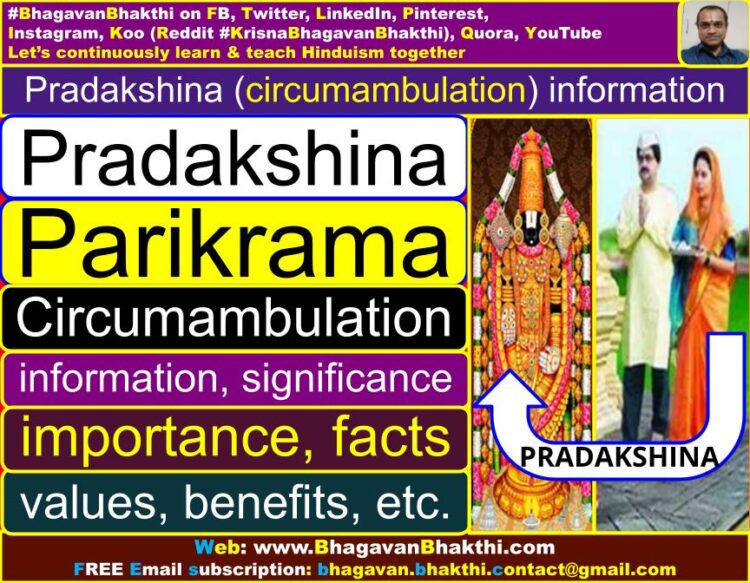
What is Pradakshina called in English? : In English it may be called as circumambulation. But this English word can’t give the exact meaning of the Sanskrit word Pradakshina.
(Note : We should always remember that Sanskrit is such a beautiful and accurate bhasha / language, if we look at any word of Sanskrit it won’t be just a word, but in fact, it will be a whole sentence.)
For example, महाभारत / Mahabharata = Here Maha + Bharata = Great + A country known as Bharata. Thus, Mahabharata means, a “Great Country called Bharata”.
Similarly, रामायण / Ramayana = Rama + Ayana = Bhagavan Sri Rama + lives in the Granta. Thus, Ramayana means, it is a grantha (Hindu divine book / text) in which Lord Sri Rama lives.
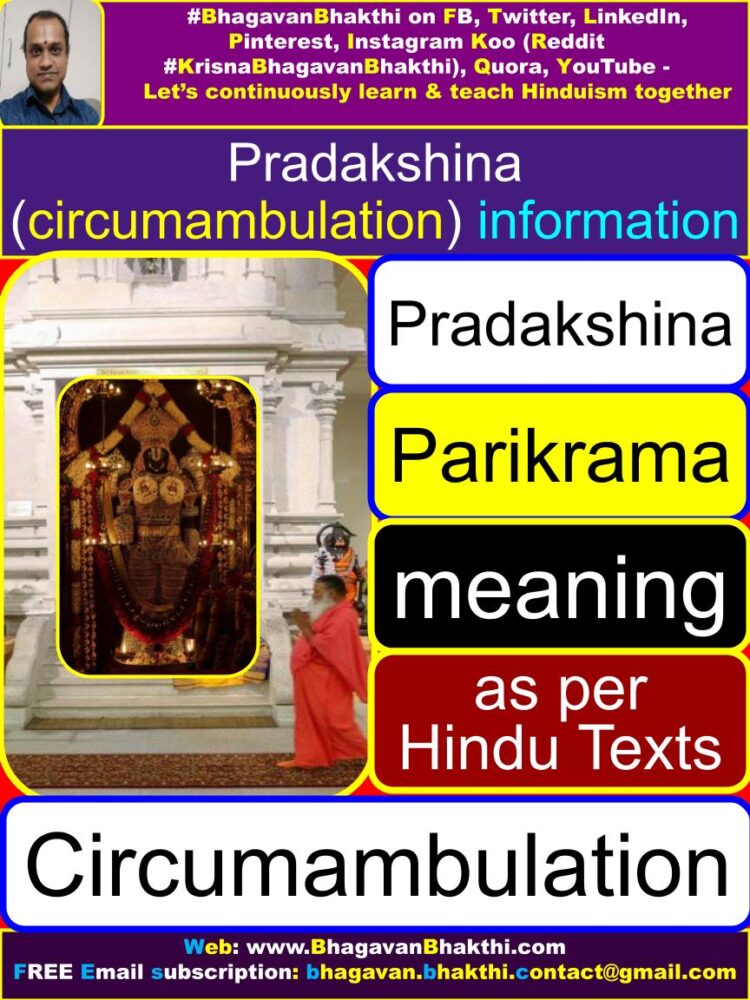
Meaning of Pradakshina is as given here: प्र / pra means something which removes all kinds of papas / sins | द / da means something which fulfils all desires |
क्षि / kshi means freedom from future births (rebirths) | ण / na means giving mukti / deliverance through Jnaana / knowledge.
Pradakshina explanation : Devotees enter a ‘Devalaya’ (temple) (mandir) and then they go around the temple (circumambulation) and / or a deity.
This circumambulation will be done normally three times, as a token of their reverence and self-surrender to the deity. This is called as Pradakshina or Parikrama.
We being active all the time with all the material and worldly thoughts in our minds, thus to change these thoughts into jnana / gyan / knowledge to a higher level.
This cannot be achieved all of a sudden and it does take lots of time for the transformation from material / laukika to adyatmika / spiritual path.
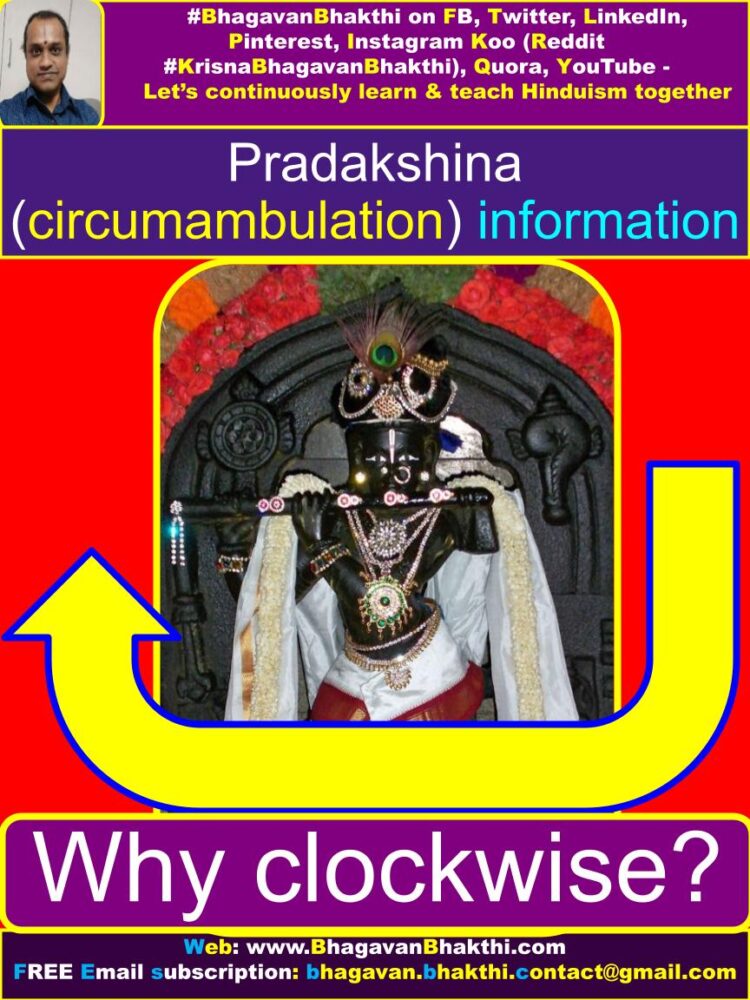
How Pradakshina or Parikrama should be done [Why do we do Pradakshina left to right (deity’s right to left)?] : As Hindus we need to do the Pradakshina or Parikrama (circumambulation) in a clockwise direction only, keeping the object (deity) of devotion to our right side.
Right side, is normally considered ‘mangalakara’ (auspicious), adyatmika, pure, correct way etc. as opposed to the anti-clockwise movement which is considered completely ‘amangalakara’, that is, inauspicious.
Keeping the deity always on our right side, implies that the deity is to be kept in good humour as we expect deity’s guidance and help.
Also in the great ‘Deva Bhasha’ (God’s language), that is, Sanskrit, ‘right side’ means ‘Dakshina’ (Sanskrit has another meaning for ‘dakshina’ – means south) has been defined as ‘Efficacy’ and ‘Pradakshina’ as ‘Special Efficacy’.
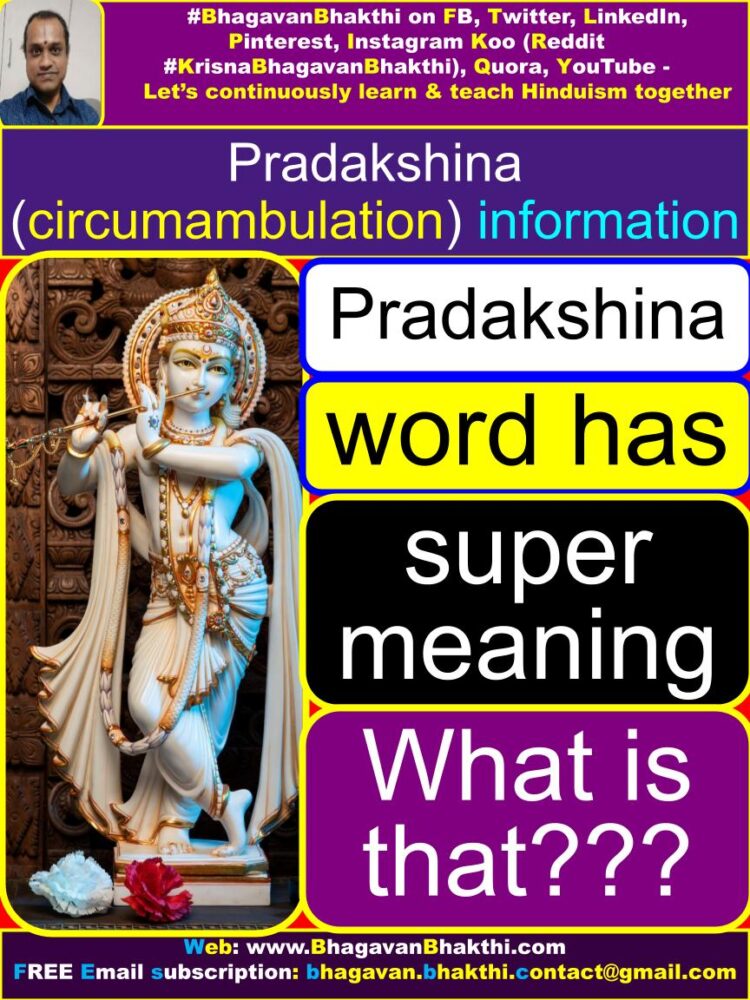
Word ‘Pradakshina’ has a super meaning as below : Here ‘pra’ means ‘prathama’ (first) and ‘dakshina’ means ‘on our right side’.
This means when we are doing the circumambulation (Pradakshina), the first thing (Prathama) we should always be thinking in our mind is of Bhagavan (God) and Bhagavan (God) should always be on our ‘right side’ (dakshina murthy – right side deity).
Pradakshina or Parikrama or circumambulation enables a devotee to be more efficacious and deserving to receive the blessings of the Bhagavan / Deity / God.
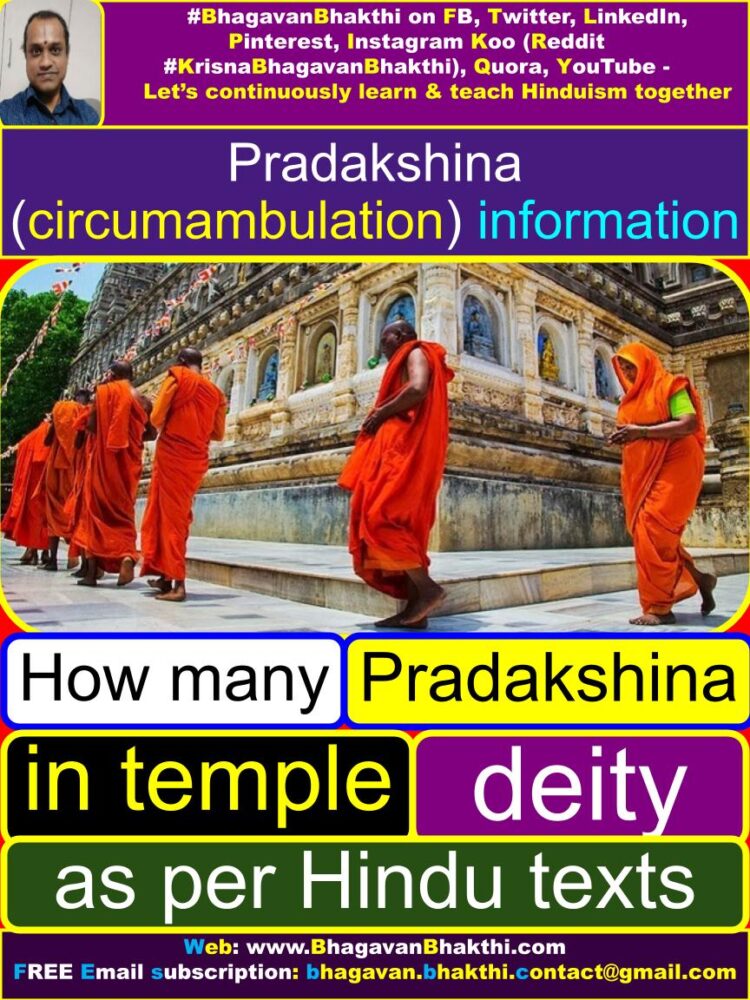
How many Pradakshina in temple or around deity : Normally, three rounds are very much in vogue. Some people do the circumambulation or Pradakshina of the Bhagavan / Deity 11 times. This is because the number 11 is also considered as highly auspicious.
Occasionally a devotee does the Pradakshina or circumambulation as many as 108 times for a specific purpose, such as:
acknowledging the fulfilment of a specific wish, seeking the fulfilment of a specific desire, as an atonement or a Praayashchittam (atonement of sin) for having done a wrong deed, self-purification etc.
There is no binding that one should do it non-stop. A devotee may take rest at as many places as he / she wants. But this should be a dishonest process.
If a devotee has really put his / her full effort and now he / she needs a real rest because he / she has become exhausted and has almost no energy, then only one may rest for some time, otherwise ‘NO’.
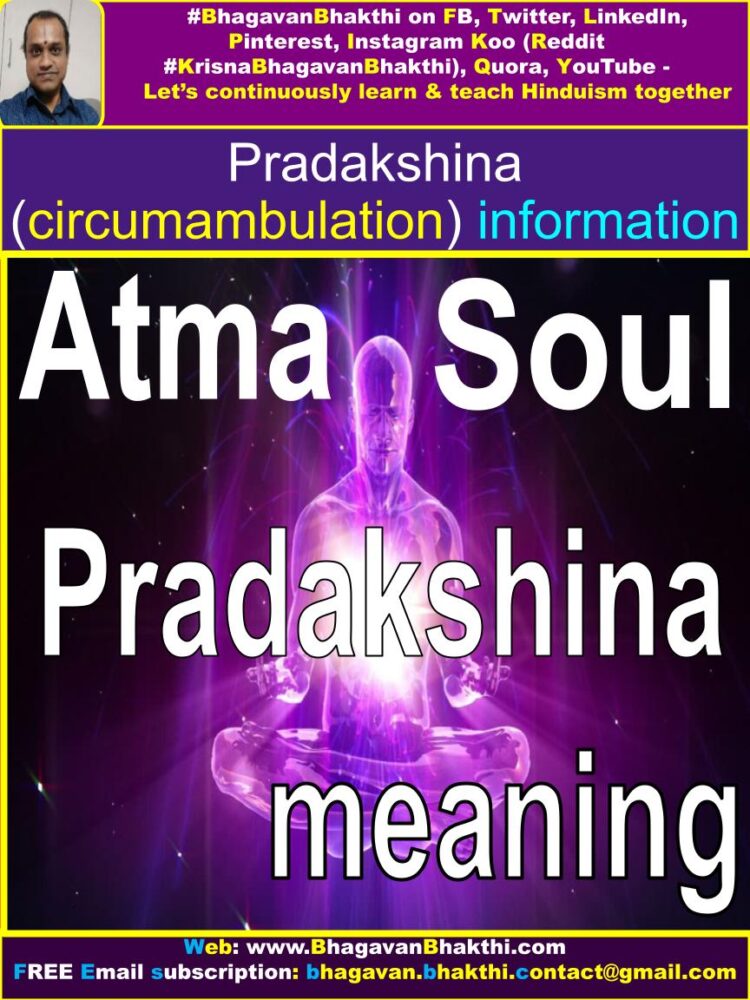
What is ‘atma pradakshina’ : Since the soul or Atma is inside our body, this would mean that he / she has made one Pradakshina (circumambulation) around ‘his own self’ and this is called as ‘atma pradakshina’.
यानी कानि च पापानि जन्मांतर कृतानि च | तानी तानी विनश्यन्ति प्रदक्षिण पदे पदे ||
ಯಾನಿ ಕಾನಿ ಚ ಪಾಪಾನಿ ಜನ್ಮಾಂತರ ಕೃತಾನಿ ಚ | ತಾನಿ ತಾನಿ ವಿನಾಷ್ಯಂತಿ ಪ್ರದಕ್ಷಿಣ ಪದೇ ಪದೇ ||
yāni kāni ca pāpāni janmāntara kr̥tāni ca। tāni tāni vināṣyanti pradakṣiṇa padē padē ।।
Meaning of this shloka is as given here (Benefit of doing Pradakshina or circumambulation) (Why do people do Pradakshina?) : All sins committed by an individual from innumerable past births (multiple rebirths) are destroyed by each step taken during Pradakshina (circumambulation).
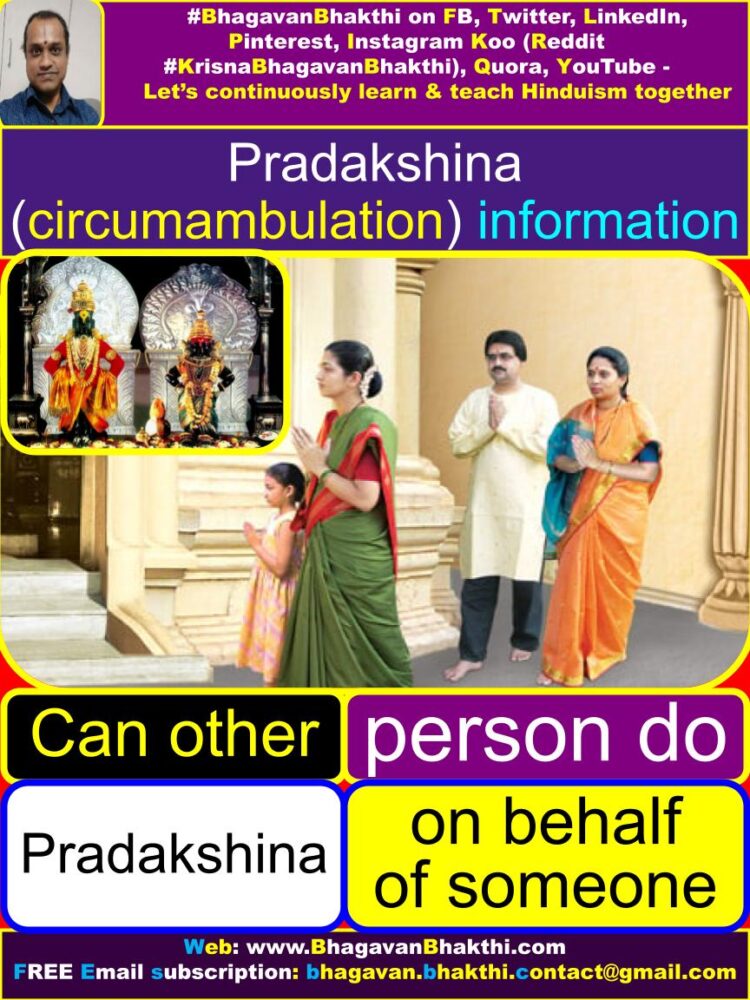
Can other person do Pradakshina on behalf of someone (If one of our relative or friend or family member is handicapped or not able to do ‘pradakshina’ or ‘circumambulation’ because of innumerable reasons, then can we do the pradakshina or circumambulation on his / her behalf.)
Answer : Definitely it can be done. This is indeed acceptable as per Hinduism / Sanatana Dharma Shastras (Hindu Texts). But we should keep in mind that the person on whose behalf we are doing the ‘pradakshina seva’ is being undertaken should be around us and the deity.
How many times should we need to do ‘pradakshina’ or circumambulation : Based on one’s physical and mental ability, one can choose from 3, 5, 11, 14, 28, 54… times. More we do, more blessings we get from Bhagavan (God).

After doing pradakshina, what should we need to do : After we successfully complete the pradakshina or circumambulation, one should spend time doing one or more Dharmic, religious, pious works and avoid wasteful activities like idle gossip, etc. Also we can sing the songs of Bhagavan (God) and other Devatas (Demigods).
Are there any regulations governing to the pradakshina and namaskaara (prostration) : Yes there are. Pradakshina (circumambulation) and namaskara should be performed in the manner prescribed by our Shastras / scriptures only and not at all as per our wish and will.
Devotees should keep the following aspects in mind while performing pradakshina:
1. If one is performing Pradakshina or circumambulation for 5 times around a deity, during each pradakshina, one should perform namaskara 4 times, one on each side (east, south, west and north) of the garbha griha (sanctum sanctorum).
Here we should always remember (chant) Bhagavan (God) and other Devatas to whom we are doing the Pradakshina or circumambulation.
2. During the Pradakshina or circumambulation time one should recite pious dharmic / religious compositions or sons as written by our great saints / devotees.
3. All men should perform the ‘sAshtanga namaskara’, whereas all females should not perform ‘Ashtanga namaskara’ wherein the entire body touches the ground. Females should kneel and perform the namaskara.
4. The person who is performing the Pradakshina or circumambulation should bathe in the river twice, taking care to wet the head.
Women need to do take bathe once. If bath is not possible at river, at least at home one should take bath.

Continue reading about Hinduism (Sanatana Dharma) :
Ramayana information, facts, significance, importance, etc.
Maharishi information, facts, importance, significance, etc.
Rivers information in Hinduism (Sanatana Dharma)
Hinduism (Sanatana Dharma) information, facts, etc.
Mahabharata information, facts, significance, importance etc.
More information will be added to his post (article) on regular basis. Please visit again to know the updated information after some time.
To watch videos on #Hinduism #Sanskrit language, SUBSCRIBE to my YouTube channel from this below link:
#BhagavanBhakthi YouTube channel
To know more about “Lord Sri Vishnu stories, information, facts, significances, etc.“, please click the below link:
Lord Sri Vishnu stories, information, facts, significances, etc.
Dear friends, if you need any clarifications about this post, kindly let me know, I will definitely try to answer all of them.
Also your one LIKE, one COMMENT, One Share, one SUBSCRIPTION is highly important.
This will help to know the quality of this content and also it will be helpful to know if any improvements is required for the content.
If you feel this content is useful to you and has helped you to improve your knowledge, kindly share this with your well-wishers.
Because “SHARING MEANS CARING”.
For receive FREE EMAIL SUBSCRIPTION about #BhagavanBhakthi, you can send an email to bhagavan.bhakthi.contact@gmail.com from your email ID.
NAMASTE!
SRI GURUBHYO NAMAHA
OM NAMO NARAYANAYA
Sri Krishnaarpanamastu
Share in Social Media